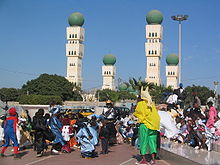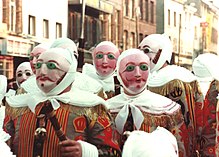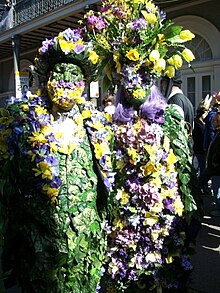This article is about the carnival. For other uses, see Mardi Gras (disambiguation).
| Mardi Gras (Also known as Shrove Tuesday or Fat Tuesday) | |
|---|---|
 Mardi Gras celebrations in New Orleans, USA | |
| Type | Local, cultural, Catholic |
| Significance | Celebration prior to fasting season of Lent. |
| 2011 date | March 8 |
| 2012 date | February 21 |
| Celebrations | Parades, parties |
| Related to | Carnival |
In many areas, the term "Mardi Gras" has come to mean the whole period of activity related to the celebratory events, beyond just the single day. In some US cities, it is now called "Mardi Gras Day" or "Fat Tuesday".[1][2][3][4][5][6] The festival season varies from city to city, as some traditions consider Mardi Gras the entire period between Epiphany or Twelfth Night and Ash Wednesday.[7] Others treat the final three-day period before Ash Wednesday as the Mardi Gras.[8] In Mobile, Alabama, Mardi Gras-associated social events begin in November, followed by mystic society balls on Thanksgiving,[7][9] then New Year's Eve, followed by parades and balls in January and February, celebrating up to midnight before Ash Wednesday. In earlier times parades were held on New Year's Day.[7] Other cities famous for Mardi Gras celebrations include Rio de Janeiro, Brazil, Barranquilla, Colombia, Sydney, Australia, Port of Spain, Trinidad and Tobago, Quebec City, Canada; Mazatlán, Sinaloa in Mexico; and New Orleans, Louisiana, United States.
Carnival is an important celebration in Catholic European nations. In the United Kingdom and Ireland, the week before Ash Wednesday is called "shrovetide", ending on Shrove Tuesday. It has its popular celebratory aspects as well. Pancakes are a traditional food. Pancakes and related fried breads or pastries made with sugar, fat and eggs are also traditionally consumed at this time in many parts of Latin America and the Caribbean.
Contents[hide] |
[edit] Belgium
In the Belgian city of Binche the Mardi Gras festival is the most important day of the year and the summit of the Carnival of Binche. Around 1000 Gilles can be found dancing throughout the city from morning till well past dusk, whilst traditional carnival songs play. In 2003, the "Carnival of Binche" was proclaimed one of the Masterpieces of the Oral and Intangible Heritage of Humanity by UNESCO.[edit] Germany
The celebration of Mardi Gras in Germany is called Karneval, Fastnacht, or Fasching.[10] Fastnacht means "Eve of the Beginning of the Fast", and is celebrated the day before Ash Wednesday.The most famous parades are held in Cologne, Mainz, and Düsseldorf on the Monday before Ash Wednesday, called Rosenmontag.
[edit] Italy
Carnevale is the traditional pre-Lenten celebration in Italy. Carnevale was Mardi Gras predecessor. The French borrowed this idea and made it popular. This is a time of merry-making, masquerade processions, masked balls, parades, pageants, jugglers, magicians, stilt walkers, elegant costumes and opulent masks, singing and dancing, fireworks, and outdoor feasts in the weeks prior to Ash Wednesday. The festivities of the last days of carnevale are the most intense as they culminate on Martedí Grasso (Mardi Gras or Shrove Tuesday). There are traditional foods and dolci (sweets) distinctively associated with carnevale, including fritelle, crespelle, sfingi, castagnole, cenci, nodi, chiacchere, bugie, galani, fritole, berlingaccio, sanguinaccio and tortelli, among others.In Milan Mardi Gras is not the climax of Carnival, since the Carnival lasts four more days, ending on the Saturday after Ash Wednesday, because of the Ambrosian rite. The last day of Carnival, therefore, is the "Sabato grasso" (Shrove or Fat Saturday).
[edit] Netherlands
The Netherlands also has a festival similar to Mardi Gras. It's called Carnaval and is similar to the Venice Carnival. The origin of the word Carnaval is 'Carne Vale' which means Goodbye to the meat in Latin. It marks the beginning of the sacred period that leads to Easter.The real festival is held in the southern part of the Netherlands in the province of Noord-Brabant and Limburg.
[edit] Sweden
In Sweden the celebration is called Fettisdagen. It comes from the word "fett" (fat) and "tisdag" (Tuesday). Originally, this was the only day one should eat semlor.[11] These are now sold in most grocery stores and bakeries preceding the holiday, and up until Easter.[edit] United States
Main article: Mardi Gras in the United States
While not observed nationally throughout the United States, a number of traditionally ethnic French cities and regions in the country have notable celebrations. Mardi Gras arrived in North America as a French Catholic tradition with the Le Moyne brothers,[12] Pierre Le Moyne d'Iberville and Jean-Baptiste Le Moyne de Bienville, in the late 17th century, when King Louis XIV sent the pair to defend France's claim on the territory of Louisiane, which included what are now the U.S. states of Alabama, Mississippi, and Louisiana.[12]The expedition, led by Iberville, entered the mouth of the Mississippi River on the evening of March 2, 1699, Lundi Gras. They did not yet know it was the river explored and claimed for France by René-Robert Cavelier, Sieur de La Salle in 1683. The party proceeded upstream to a place on the west bank about 60 miles downriver from where New Orleans is today, and made camp. This was on March 3, 1699, Mardi Gras, so in honor of this holiday, Iberville named the spot Point du Mardi Gras (French: "Mardi Gras Point") and called the nearby tributary Bayou Mardi Gras. Bienville went on to found the settlement of Mobile, Alabama in 1702 as the first capital of French Louisiana.[13] In 1703 French settlers in Mobile began the Mardi Gras celebration tradition.[12][14][15] By 1720, Biloxi had been made capital of Louisiana. The French customs had already accompanied colonists who settled there.[12]
In 1723, the capital of Louisiana was moved to New Orleans, founded in 1718.[13] The tradition has expanded to the point that it became strongly associated with the city in popular perception, and embraced by residents of New Orleans beyond those of French or Catholic heritage. Mardi Gras celebrations are part of the basis of the slogan, Laissez les bons temps rouler, (Let the good times roll) and the nickname "Big Easy".[12] Mobile, Alabama, the former capital of New France, also has a long tradition of celebrating Mardi Gras. Other cities along the Gulf Coast formerly occupied and owned by the French from Pensacola, Florida, and its suburbs to Lafayette, Louisiana, have active Mardi Gras celebrations. In the rural Acadiana area, many Cajuns celebrate with the Courir de Mardi Gras, a tradition that dates to medieval celebrations in France.[16] In more recent times several other U.S. cities without a French heritage have instituted a kind of Mardi Gras celebration; for instance, the UETA Jamboozie festival is held late January in Laredo, Texas.
In the last decade of the 20th century, the rise in producing commercial videotapes catering to voyeurs helped encourage a tradition of women baring breasts in exchange for beads and trinkets.[17] This is practiced only in very small fragments of where Mardi Gras is celebrated, mostly by visitors rather than locals.
[edit] See also
[edit] References
- ^ a b In Australia, Mardi Gras season: "NSW: Mardi Gras still alive and well, say organisers", encyclopedia.com, 2003, webpage: ency-596.
- ^ a b In London, Mardi Gras season: "Paul's Pastry Shop kneads a ton of dough in Picayune", Allbusiness.com, 2008, webpage: Allbusiness-35.
- ^ a b In New Orleans, Mardi Gras season: "Mardi Gras in New Orleans | Metro.co.uk", Metro.co.uk, 2009, webpage: Metro.co.uk-2315.
- ^ a b In Mobile, Mardi Gras season: "New Orleans has competition for Mardi Gras", USATODAY.com, February 2006, webpage: USATODAY-com-mardi.
- ^ a b In San Diego, Mardi Gras season: "sandiego.com - Mardi Gras in San Diego: FAQ's", SanDiego.com, 2008, webpage: SanDiego.com-SD.
- ^ a b In Texas, Mardi Gras season: "Let’s Celebrate: Mardi Gras 2008", Southernbyways.com, January 2008, webpage: southernbyways-com-TX.
- ^ a b c "Mardi Gras Terminology". "Mobile Bay Convention & Visitors Bureau". Retrieved November 18, 2007.
- ^ "The Season of Lent". Crivoice.org. January 7, 2010. Retrieved October 16, 2010.
- ^ "Mobile Carnival Association, 1927", MardiGrasDigest.com, 2006, webpage: mardigrasdigest-Mobile.
- ^ [1][dead link]
- ^ "Swedish semla: more than just a bun". Sweden.se. Retrieved February 22, 2011.
- ^ a b c d e "New Orleans & Mardi Gras History Timeline" (event list), Mardi Gras Digest, 2005, webpage: MG-time.
- ^ a b "Timeline 18th Century:" (events), Timelines of History, 2007, webpage: TLine-1700-1724: on "1702-1711" of Mobile.
- ^ "Mardi Gras in Mobile" (history), Jeff Sessions, Senator, Library of Congress, 2006, webpage: LibCongress-2665.
- ^ "Mardi Gras" (history), Mobile Bay Convention & Visitors Bureau, 2007, webpage: MGmobile.
- ^ "Mardi Gras in Rural Acadiana". Retrieved February 18, 2010.
- ^ Shrum, W. and J. Kilburn. "Ritual Disrobement at Mardi Gras: Ceremonial Exchange and Moral Order". Social Forces, Vol. 75, No. 2. (Dec., 1996), pp. 423-458.
[edit] External links
- Traditional Cajun Mardi Gras Celebrations
- Mardi Gras in Mobile, Encyclopedia of Alabama
- Prof. Carl Nivale's Compleat Carnival Compendium and Mardi Gras Manual
- Mardi Gras 2009 celebration photos
- Mardi Gras Costumer photos in New Orleans
- Where to Celebrate Mardi Gras Around the World - slideshow by The Guardian



